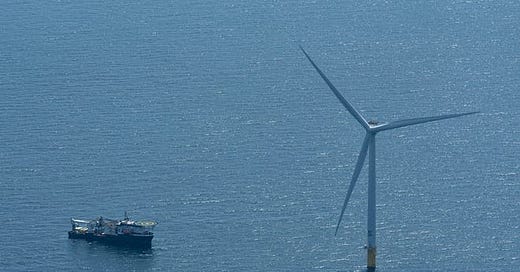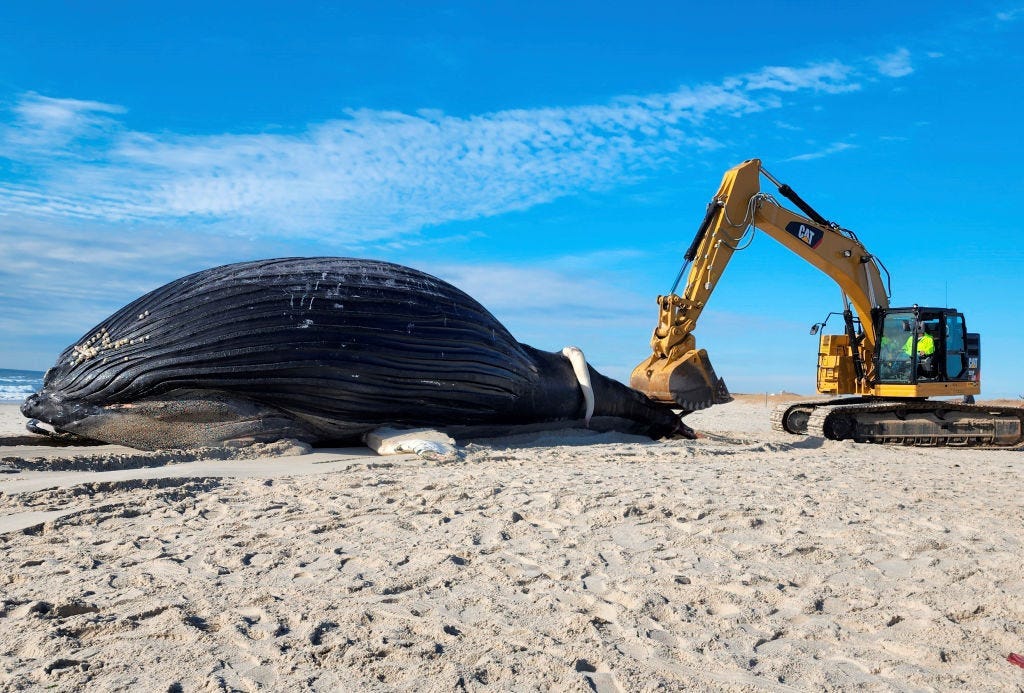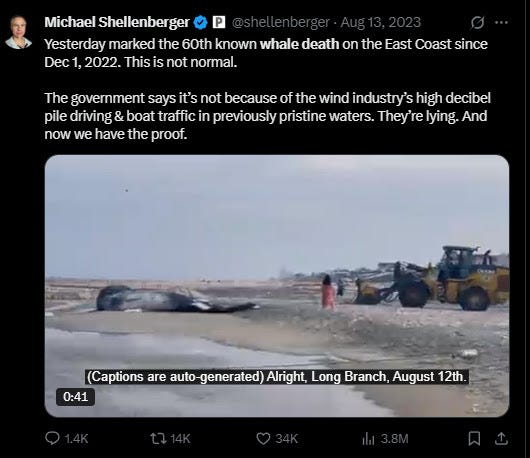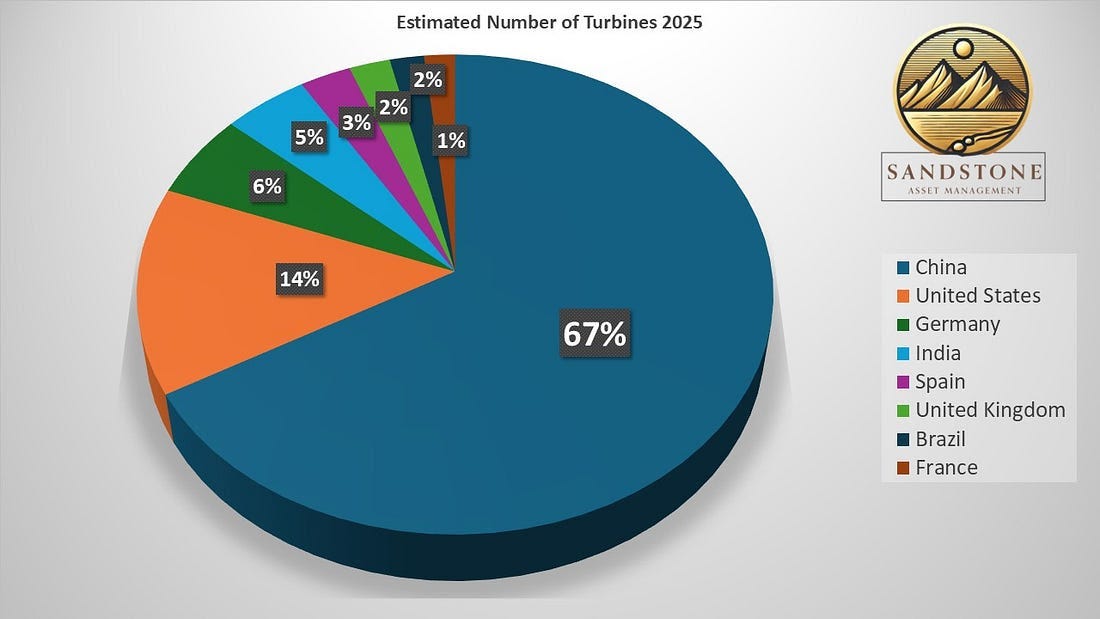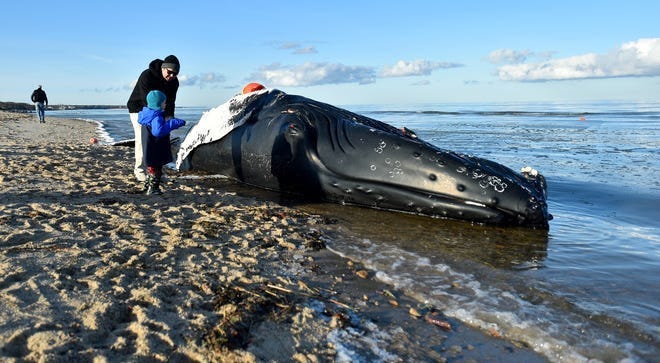HEADLINE: “Can We Rely on Wind Energy When Dunkelflautes Strike?”, By STU TURLEY
“Why is Google shutting down the statistics on whale deaths?”
Can We Rely on Wind Energy When Dunkelflautes Strike?
Why is Google shutting down the statistics on whale deaths?
JUN 3
While writing this story about some of the key issues surrounding wind, I noticed a pattern in search responses over the last several months related to whale deaths. All of the stories start by stating, “No whale deaths are caused by wind,” and then go on to cite different “scientists.” Will Substack censor us next?
So I go to Brave and search, and the first article pops up: Whales Are Dying Along the East Coast. And a Fight Is Surfacing Over Who’s to Blame
Along with picking up sick baby seals and dolphins, the MMSC helps to carry out examinations on the bodies of dead whales when they wash up on the shores of New York and New Jersey in order to collect scientific data, and hopefully help determine a cause of death. And in recent months, whales have been washing up on these shores with alarming frequency. Eight large whales, including sperm whales and humpbacks, have washed up in the area since December. Those deaths have become a focal point in the clean energy culture war, with conservative media commentators blaming them on preliminary site-mapping work for offshore wind developments. But evidence to support those claims hasn’t turned up. That’s brought down the ire of many people opposed to offshore wind on small animal welfare organizations like MMSC for supposedly hiding the truth of what killed those whales.
While the article did not say that the wind farms were killing the whales, at least the browser Brave found it, and the author was more open to the fact that there is a problem with offshore wind and whale deaths.
In 2023, Michael Shelleberger published several key stories on this topic.
Several key things are happening. People are just starting to understand that the Grid needs the correct frequencies, dispatchable power, and fiscal responsibility.
So David Blackmon's line, “Physics matters to the Grid,” is a great line, and when you add my comment, “Without physics and fiscal responsibility, grids will fail.”
Can We Rely on Wind Energy When Dunkelflautes Strike?
As the world races toward net-zero carbon emissions, wind energy has emerged as a cornerstone of renewable energy strategies. In 2023, global wind power capacity surpassed one terawatt, with projections to double within a decade. Yet, a significant challenge looms over this clean energy darling: the Dunkelflaute. This German term, meaning “dark lull,” describes periods of low wind and minimal sunlight, when wind turbines and solar panels produce little to no electricity. For countries betting heavily on wind, Dunkelflautes pose a critical question: Can we rely on wind energy when nature refuses to cooperate?
What Is a Dunkelflaute, and Why Does It Matter?
A Dunkelflaute occurs when weather conditions—typically high-pressure systems in winter—bring calm winds and overcast skies. These events can last days or even weeks, severely curtailing wind and solar output. In Europe, where wind accounts for a significant share of electricity (e.g., 17% in the EU in 2022), Dunkelflautes have exposed vulnerabilities in renewable-heavy grids. For instance, Germany’s 2021 Dunkelflaute led to a spike in fossil fuel use, with coal and gas plants stepping in to fill the gap. The UK, another wind energy leader, has faced similar challenges, with National Grid reporting increased reliance on gas during low-wind periods.
The issue is not merely technical but economic and political. Energy markets spike during Dunkelflautes, driving up costs for consumers. Politically, these events fuel skepticism about renewables, with critics arguing that wind’s intermittency undermines its reliability. So, how can we address this challenge while maintaining wind’s role in the energy mix?
Strategies to Mitigate Dunkelflaute Impacts
Energy Storage Solutions: Batteries, such as lithium-ion or emerging solid-state technologies, can store excess wind energy during high-production periods for use during Dunkelflautes. However, current storage capacity is limited—global battery storage in 2023 was only about 120 GWh, a fraction of what’s needed for multi-day lulls. Pumped hydro and green hydrogen are promising but require significant infrastructure investment. In my opinion, the only viable energy storage solution is a lot of work, and it is not a proper solution. Water movement ponds can be a solution, but do they work? When you expend more energy than you gain, it is not a solution, and battery storage solutions really are not there yet. We spend a lot more money than we get back out, and when batteries need to be recycled, there is a huge problem that I will cover later. Batteries are an environmental problem.
Grid Diversification and Interconnectivity: Combining wind with other renewables (e.g., solar, hydro, or geothermal) reduces reliance on any single source. Cross-border grid interconnectors, like those in Europe, allow countries to import power from regions unaffected by local weather. For example, Norway’s hydropower can balance Germany’s wind shortfalls.
Backup Power and Demand Response: Natural gas plants with carbon capture, nuclear, or even coal in some regions can serve as backup during Dunkelflautes. Demand response programs, which incentivize reduced consumption during peak times, also help. However, scaling these solutions without undermining decarbonization goals is tricky.
Overbuilding Capacity: Installing more wind turbines than needed for average demand ensures some output even during low-wind periods. This approach, while effective, raises costs and environmental concerns, as we’ll explore below.
Wind Turbine Capacity in Top Countries
To understand wind energy’s global footprint, let’s examine the top eight countries by installed wind power capacity as of 2023. Below is a summary, with detailed data available in the CSV export.
China: ~400 GW, ~350,000 turbines
United States: ~140 GW, ~73,000 turbines
Germany: ~70 GW, ~30,000 turbines
India: ~45 GW, ~25,000 turbines
Spain: ~30 GW, ~15,000 turbines
United Kingdom: ~30 GW, ~12,000 turbines
Brazil: ~25 GW, ~10,000 turbines
France: ~20 GW, ~9,000 turbines
These figures reflect a mix of onshore and offshore installations, with China leading by a wide margin, accounting for 36% of global wind electricity in 2022. The number of turbines is estimated based on average turbine sizes (e.g., 2–4 MW for modern turbines), as exact counts vary by source.
Land reclamation is going to be a gigantic problem, and who is going to pay for that? If you have listened to the podcast, you may have heard me talk about the $350,000 to $950,000 for each turbine just to get to the recycled parts, and this number is low.
Environmental Impacts of Wind Farms
While wind energy is cleaner than fossil fuels, it’s not without environmental trade-offs. Here are three key concerns: soil drying, changes in wind patterns, and wildlife mortality.
Soil Drying: Wind farms can alter local microclimates, potentially drying out soil. Large turbines disrupt airflow, reducing moisture retention in the soil downwind. A 2018 Harvard study found that wind farms in the U.S. could warm surface temperatures by 0.24°C, with implications for soil moisture. However, quantitative data on soil drying is scarce, and impacts vary by region. For instance, arid areas may be more vulnerable than temperate ones. Mitigation strategies, like spacing turbines to minimize airflow disruption, are under study but not yet widely implemented.
Changes in Wind Patterns: Wind turbines create “wind shadows,” where air slows behind the blades, reducing wind speeds downwind. This effect, documented in a 2013 study by David Keith, can lower the efficiency of nearby turbines and alter local weather patterns. At large scales, wind farms act as active players in the climate system, potentially affecting precipitation and temperature. While these changes are localized, they underscore the need for careful site planning to minimize cumulative impacts.
Wildlife Mortality: Wind turbines pose a threat to birds and bats, both through direct collisions and indirect effects like habitat loss and barotrauma (lung damage from pressure changes near blades). Estimates vary, but studies suggest:
Birds: Globally, wind turbines kill hundreds of thousands of birds annually, though this is less than 0.4 birds per GWh of electricity, compared to over 5 birds per GWh for fossil fuel plants. In Ontario, Canada, each turbine kills about 5 birds per year.
Bats: Bat fatalities are higher, with estimates of 6–20 bats per turbine per year globally. In Ontario, each turbine kills about 12 bats annually. In the U.S., tens to hundreds of thousands of bats die yearly at wind farms, with some species at risk of extinction.
Other Wildlife: Impacts on terrestrial mammals are less studied but include habitat fragmentation and noise disturbance during construction. Offshore wind farms may disrupt marine life, though some create artificial reefs benefiting certain species.
Mitigation efforts include curtailment (stopping turbines at low wind speeds to protect bats), painting blades black to deter birds, and using ultrasonic deterrents. Siting turbines away from migration routes and sensitive habitats is also critical.
Balancing Wind’s Promise and Pitfalls
Wind energy’s intermittency, exemplified by Dunkelflautes, demands a multifaceted approach: storage, grid integration, backup power, and strategic overbuilding. While wind’s environmental footprint is lighter than fossil fuels, concerns like soil drying, wind pattern changes, and wildlife mortality require ongoing research and mitigation. The top wind-powered nations demonstrate the scale of investment in this technology, but scaling up further must address these challenges head-on.
As we navigate the energy transition, wind remains a vital tool—but not a silver bullet. By pairing it with complementary technologies and robust environmental safeguards, we can harness its potential while weathering the storms, or lulls, that come with it.
Sources: U.S. Geological Survey, U.S. Fish & Wildlife Service, National Academies Press, Integrity Energy, Department of Energy, Harvard Gazette, WindEurope, Wikipedia, Union of Concerned Scientists, and others. Full citations available upon request.
Additional Notes on Environmental Impacts
Soil Drying: Quantitative data on soil drying is limited. The 2018 Harvard study suggests localized warming and potential moisture loss, but no global or country-specific metrics exist in the provided references. Further research is needed to quantify this impact, especially in agricultural regions hosting wind farms.
Wind Pattern Changes: Wind shadows and atmospheric interactions are well-documented, but their long-term ecological or climatic effects remain understudied. The Harvard study indicates that large-scale wind farms could influence local weather, but precise measurements of wind speed reductions or downstream impacts are site-specific.
Wildlife Mortality:
Birds: Global estimates are rough due to inconsistent monitoring. The figure of <0.4 birds per GWh is a median from studies, but actual numbers depend on turbine location and species. For example, raptors and migratory birds are more vulnerable.
Bats: Bat mortality is a greater concern due to their slow reproduction rates. The 6–20 bats per turbine per year estimate is conservative, with higher rates in migration corridors. Barotrauma is a unique issue for bats, complicating mitigation.
Other Wildlife: Data on non-flying wildlife is sparse. Construction-related habitat disruption is the primary concern, but long-term effects on mammals or insects are poorly quantified.
Whales and Marine life
The research is being withheld, and it depends on what search tools you are using, and Grok on X just responded, “No whales are being killed, as it has been debunked by NOAA.” And that is a load of bull.
The above picture is from Merrily Cassidy/Cape Cod Times
I have a podcast next week with Energy Transition Absurdities (David Blackmon) and Meghan Lapp to discuss this problem in detail.
Thank you for the Recommended Reading by Rafe Champion - and the idea for the podcast and the story.
BOTTOMLINE: “The research is being withheld, and it depends on what search tools you are using, and Grok on X just responded, “No whales are being killed, as it has been debunked by NOAA.” And that is a load of bull.”

